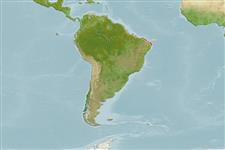分類 / Names
俗名 | 同種異名 | Catalog of Fishes(屬, 種) | ITIS | CoL | WoRMS | Cloffa
Teleostei >
Blenniiformes (Blennies)
鱸形目 (Blennies) >
Dactyloscopidae (Sand stargazers)
指鰧科 (Sand stargazers)
Etymology: Platygillellus: Greek, platys = flat + Theodore Nicolas Gill (1837-1914) researcher of abyssal fishes and systematics (Ref. 45335); brasiliensis: Named for its distribution and probably endemic in Brazil.
Environment: milieu / climate zone / depth range / distribution range
生態學
海洋 居於水底的; 深度上下限 1 - 2 m (Ref. 56973). 熱帶
Southwest Atlantic: Brazil.
西南大西洋: 巴西。
大小 / 重量 / 年齡
Maturity: Lm ? range ? - ? cm
Max length : 4.1 cm SL 雄魚/尚未辨別雌雄; (Ref. 56973); 4.0 cm SL (female)
簡短描述
檢索表 | 型態特徵 | 形態測量圖
Diagnosis: The dorsal finlet is fan-like and 3-spined, its height more than half of predorsal length, 58-84% (vs. 4-spined in P. smithi, low profile in P. rubrocinctus); first 2 spines of finlet more closely spaced than the 2nd and 3rd. Lateral line deflection is usually located below interspace between 14th and 15th dorsal fin elements. Upper lip fimbriae more numerous than those of lower lip. Base of pectoral fin usually naked or rarely with a single scale on its upper portion (Ref. 56973).
Known from shallow reefs; inhabits the margins of sand flats in small caves and below reef walls at depths of 1 to 6 meters; these areas are deposits of coarse gravel largely composed of f fragments of mollusc shells, crustaceans, corals, calcareous algae and sea urchin skeletons and spines. Found buried in the gravel, with just the eyes and the dorsal finlet exposed; it appears to 'swim' in the gravel; solitary or in groups. Associates with other sand-dwelling fishes such as Dactyloscopus tridigitatus, D. crossotus, Gillellus greyae, and toadfish Thallasophynne punctata; also an unidentified shrimp and juveniles of crabs (Callinectes sp.).
Life cycle and mating behavior
成熟度 | 繁殖 | 產卵場 | 卵 | 孕卵數 | 仔魚
西南大西洋: 巴西。
Feitoza, B.M., 2002. Platygillellus brasiliensis n. sp. (Perciformes: Dactyloscopidae), the third species of the genus from the Atlantic. aqua, J. Ichthyol. Aquat. Biol. 6(1):21-28. (Ref. 56973)
IUCN 瀕危狀態 (Ref. 130435: Version 2024-2)
無危 (LC) ; Date assessed: 24 March 2011
人類使用
工具
特別的報告
下載 XML
網路資源
Estimates based on models
Preferred temperature (Ref.
123201): 27 - 27.6, mean 27.5 °C (based on 44 cells).
Phylogenetic diversity index (Ref.
82804): PD
50 = 0.5156 [Uniqueness, from 0.5 = low to 2.0 = high].
Bayesian length-weight: a=0.00389 (0.00180 - 0.00842), b=3.12 (2.94 - 3.30), in cm total length, based on all LWR estimates for this body shape (Ref.
93245).
營養階層 (Ref.
69278): 4.0 ±0.6 se; based on size and trophs of closest relatives
Fishing Vulnerability (Ref.
59153): Low vulnerability (10 of 100).
